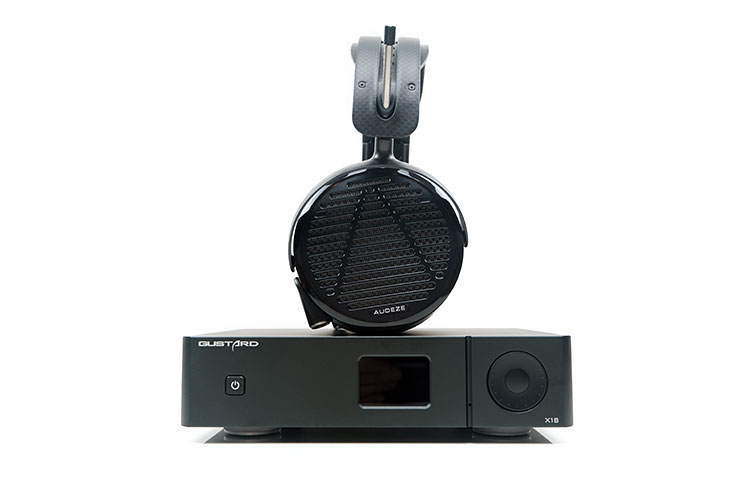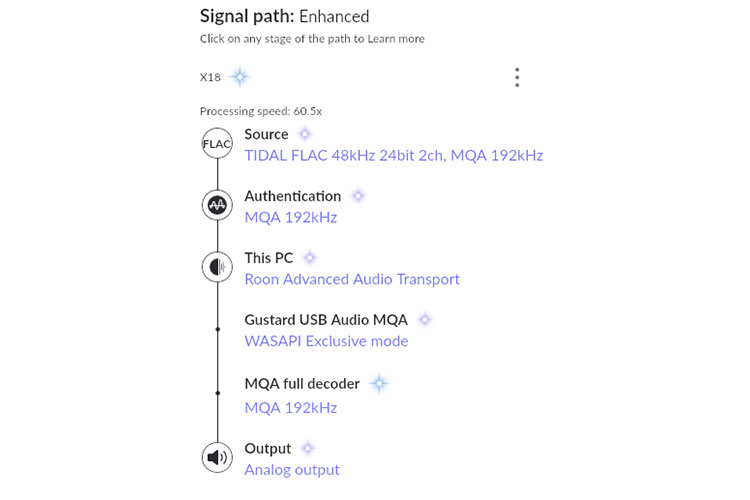Sound Impressions
Summary
The Gustard X18 DAC sonic performance can be loosely described as the X16 on steroids. What I mean by that is the sense of power and dynamics from any setup including the X18 as a DAC sounded a lot more authoritative and engaging compared to the X16.
I suspect the enhanced output Vrms rating, going from 2V to 2.5V SE and 4V to 5V balanced is one factor but the other really sounds like Gustard taking advantage of the new DAC implementation to fine-tune what I would describe as a more natural tonal quality compared to its ‘smaller sibling’.
There is not a massive change in the tonal bias. I would still describe the X18 DAC as a fairly neutral-sounding reference type of delivery but this time some of the quirks of the X16 sound signature are dampened down a lot more, primarily in its enhanced physicality and smoother treble overtone.
I had remarked in the X16 review that the NOS setting did scrape a little bit of glare off the treble response of the X16 but in switching to NOS you also got a more rounded and flat sound that really captures your attention. Amplifier matching was a more studied process as a result of a tendency to pick warmer amps using oversampling and cooler amps with NOS.
Not so with the X18. You can keep that NOS turned off and get a proper clean treble presence but with far less of that glare and a much smoother-sounding performance. The X18 DAC sounds equally at home with clean and revealing amplifiers such as the Ferrum OOR as it does with analog tube amps such as the Auris HA-2SE.
Timbre
This is one of the more pleasing aspects of the X18 DAC’s performance. I still get a fairly linear tonal shaping from transparent amplifiers such as the OOR but instead of a lightish level of note body and a slightly odd-harmonic bias, the X18 delivers much more evenly balanced harmonics and improved note texture.
And the girth is much ‘fatter’ with a better fundamental generated from improved low-end dynamics. The X18 can punch, and it can reach fairly deeply also. I would still say the likes of the Musician Audio Pegasus and the Chord Qutest can reach a bit deeper but the punch and vibrancy of the X18 are on par and at times more lively sounding also.
The treble is a shade smoother, but still a little on the dry side for me with some percussion passages abruptly halting rather than naturally fading away. As before, with NOS turned on will give you a slight diminution of treble energy and a more rounded tone but you can tell that Gustard has improved their algorithm for the oversampling.
The glassier and even drier tone of the X16’s oversampled treble performance bleeds more into vocal performance with sibilance sounding more prominent on colder sounding solid-state amplifiers. You get a much better balance from the X18 and far less sibilance, as a result, making it by far the easier of the two DAC for pairing with revealing amplifiers.
Staging & Dynamic Range
The X16’s excellent imaging remains with the X18; however, the instrumental separation has improved for me, especially when using the balanced output over SE which pushes a wider staging quality and improved channel separation.
However, what really stands out is the power and dynamic range of the X18. There must be something in the ‘DAC water’ in 2022 because both the X18 and the high-end ERCO use a Saber DAC implementation and both deliver excellent bass dynamics with the likes of the LCD-5 that were once the preserve of older AKM chipsets.
The X18 reaches relatively deep but your ear really focuses on the punch which is more aggressive than the X16 and also smoother and fuller sounding. Not that the staging is overly biased to the low-end, but rather it feels properly supported and convincingly layered this time around.
Bass and lower mids instrument notes convey a lot more authority and sound more convincing as a result. Vocals seem to have more presence and focus also, perhaps even more so compared to the ethereal Qutest. This is normally where my ear will sit when it comes to how exactly the X18 imaging and presence perform with our tested amps.
I would still say DACs like the Qutest have a slight edge in top-end extension and presence. The X18 extends well, but a slight attenuation on the upper treble presence tends to give it a slightly spartan vibe with the same tracks that swirl and hover in a more complex manner with the Qutest.
Synergy
Compatibility
Unfortunately, the issues that hounded the X16 from my previous review experience remain with the X18 DAC. The I²S connection standard in this device is different from the various standards used with other devices I might have wanted to connect to the X18, such as a streamer or modern CDP.
The test units were the same as the last time, a Cayin iDAP-6 and a NuPrime CDP-9, both of which offered additional functionality such as CD transport and in the case of the Cayin, network lossless streaming. In the case of the Cayin, it was stuck on DSD64 with a heavily degraded signal from the left channel and no audio at all from the CDP-9.
I will not go far as to say the X18 I²S format is a busted flush but without a supplied compatibility list from Gustard, I would not risk bringing in an X18 unit to pair with the likes of a Cayin or NuPrime. I presume these are companies that have a single standard for all their I²S devices so results will likely be the same for their I²S DAPs such as the N6ii’s mini I²S port.
As with the X16, my advice is to stick to the X18 USB, Coaxial, or optical for your main modular digital inputs if you plan on adding a streamer or a transport.
Bluetooth Audio
If you have an LDAC compatible transmitting source such as a good quality smartphone or a streamer then I would suggest going down that route over aptX, SBC, or AAC. You tend to lose a lot of nuanced detail and air with the more compressed codec formats that usually result in a softer and slightly saggy low-end and an attenuated top-end.
aptX Classic on Windows 10 was a bit soft and lacking in definition on the low-end compared to LDAC and less resolving in terms of top-end presence.
I was able to get a far superior treble performance and improved dynamic range using LDAC via a Samsung Z Flip 3 via the X18 into a Ferrum OOR compared to its aptX or SBC equivalent when turning off the LDAC mode.
One other thing to note, switching from lower codec formats to LDAC seems to result in a volume jump alongside the aforementioned improvements so be careful you do not give yourself a fright. We tested and confirmed this on 2 Smartphones and the Cayin N6ii switching from SBC to LDAC and back again.
As far as qualitative differences go between the source signals, I found the Samsung Z Flip 3 LDAC transmission to have a slightly superior dynamic range to the N6ii version on the X18 but at the cost of some additional edginess in the treble and upper mids. The N6ii seemed more relaxed by comparison, though not by much.
MQA
There is no ASIO driver for the X18. You get WASAPI only at the time of writing which is easily picked up by our PC’s Roon Core and remote-controlled by our Roon endpoint Android app with maximum ease.
It is not easy to find the top-tier 192kHz tracks these days in TIDAL but find them we did and the X18 handled them with aplomb showing a full decoding capability of 192k and the MQA status label showing up on its OLED display.
It is not officially a Roon-certified device but once you enable WASAPI you can also dip your toes into Roon’s excellent DSP PMEQ and speaker filters which I highly recommend for shaping your final audio output. It is much more effective than the digital filters included on the X18 which are drawn from the ES9038PRO chipset.
Amplifier Pairings
Tested with an Audeze LCD-5 and a T+A Solitaire P using the X18 USB digital input, (WASAPI), and Roon PC with FLAC ranging from 44.1kHz to DSD128.
Generally, the X18 provides a more flexible pairing solution than the X16 for a few reasons. The first is the higher-rated output voltage on those analog outputs giving it a bit more of a dynamic punch with our tested amplifiers.
When comparing the X16 (see in more detail on page 3), the X18 required less volume and sounded the livelier of the two DACs, even when subjectively matched using the respective volume controls.
The second reason is the timbral changes, particularly in note body and treble presence. With the X18 delivering a slightly warmer tinge and enhanced body, particularly through the mid-bass punch and upper-mids percussion, it sounded the more appropriate fit for hyper-clean solid-state amplifiers such as the Ferrum OOR
Cooler or sweeter-sounding solid-state amps such as the OOR or the Formula S tended to be too revealing for the X16’s thinner edgier tone whereas the X18 DAC’s performance seems right on the line of neutral to slightly natural and much more inviting for long listening sessions.
Even with tube amplifiers such as the Auris Audio HA-2SE, you can pick up on those treble overtones from the X16 compared to the smoother X18 so it is not an exclusive trait for solid-state reference amps.
The HA-2Se is generally an analog-sounding midrange-focused tube amplifier. With the X18 feed, it sounded physical, clear, and tight but nothing sibilant or tinny sounding. You will find the level of decay a little drier or shorter compared to the more liquid-sounding R2R Pegasus DAC but it still breaks and decays in a more natural manner compared to the X16.
Click on page 3 below for select comparisons





